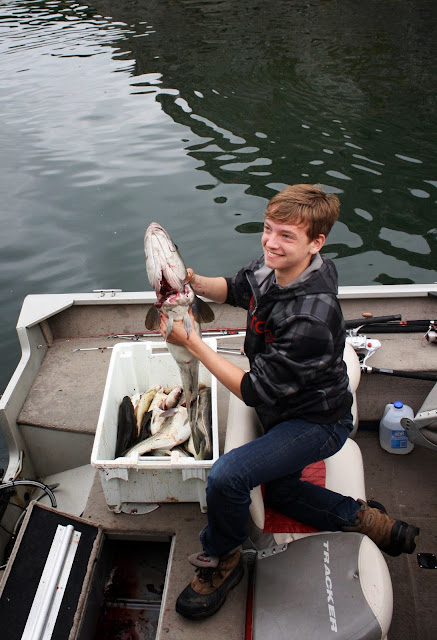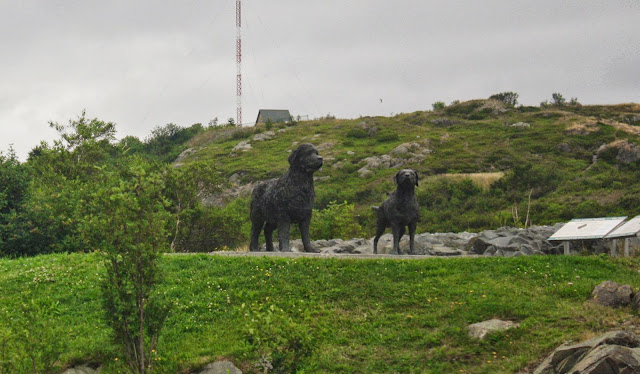We had a bus tour of St. John's Newfoundland. The first stop was Quidi Vidi Bay. Quidi Vidi (pronunciations vary, even amongst longtime residents, but "Kiddy Viddy" is the most common).

Quidi Vidi was known for once being a historic fishing village. It was active after World War II for the construction of Pepperrell Air Force Base. Field work near Quidi Vidi Lake began on October 15, 1940.

The neighborhood is named for both Quidi Vidi Lake (where the Royal St John's Regatta is held the first Wednesday in August, weather permitting). We missed this event by one day. The Quidi Vidi Harbour is known locally as "The Gut". The village is also home to Newfoundland's largest microbrewery, the Quidi Vidi Brewing Company. We stopped close and some of the group strayed in.
In 1930 the film The Viking (named for a sealing ship) in Quidi Vidi was filmed here. Also another film was made here having something to do with whales. I can not remember the name of it. They had mechanical whales in the bay and all.

This father and son team had just come in from fishing and let us take pix of the catch. The big one is cod. I am not sure if all are cod or not.


Means a meeting place of people.

The two dog breeds to come from this area. The Newfoundland and the Labrador.
The Newfoundland is a working dog. Newfoundlands can be black, brown, or black and white (Landseer). They were originally bred and used as a working dog for fishermen in the Dominion of Newfoundland. They are known for their giant size, tremendous strength, calm dispositions, and loyalty. Newfoundland dogs excel at water rescue/lifesaving because of their muscular build, thick double coat, webbed feet, and innate swimming abilities.

Signal Hill
The final battle of the Seven Years War in North America was fought in 1762 at the Battle of Signal Hill, in which the French surrendered St. John's to the British under the command of Lt. Colonel William Amherst. Lt. Colonel Amherst renamed what was then known as "The Lookout" as "Signal Hill," because of the signalling that took place upon its summit from its flagmast. Flag communication between land and sea would take place there from the 17th century until 1960.

The Signal Hill Tattoo showcases the Royal Newfoundland Regiment of Foot. Wearing full military uniforms circa 1795, the soldiers give a military concert by the Regimental fifes and drums, and demonstrate the musket, drills, and battle formations of the time. The Artillery provide an exhibition of cannon fire.





The eastern most point in North America

Cape Spears Lighthouse and shore.

A lighthouse has operated at Cape Spear since September 1836. The original Cape Spear lighthouse was the second lighthouse built in Newfoundland; the first was built in 1810 at Fort Amherst, at the entrance to St. John's Harbor. In 1832, the first legislative assembly for the colony created a lighthouse board. Cape Spear was chosen as the site for a new lighthouse because it was on the rocky eastern coast near the entrance to St John's harbor.
Construction began in 1834. The first lighthouse was a square wooden building with a tower in the middle containing the light. A foghorn was added in 1878.
We had lunch in town. It was great and we got to try Partridge berry on our cheesecake. Partridge berries are internationally known as lingonberries. This relative of the cranberry family is a low mat forming evergreen shrub with tiny rounded leaves. These berries grow in the dry, acidic soils of Newfoundland and Labrador's barrens and coastal headlands. Their flowers have a pinkish hue in bud then turn white as they bloom in mid-June to mid-July. The flower ovaries gives rise to a single dark red berry ripening through September's frost. Tart in flavor they are high in vitamin C, tannin, anthocyanin, and antioxidants.
September's frost. Tart in flavor they are high in vitamin C, tannin, anthocyanin, and antioxidants.
Oh, I forgot to tell you when we crossed the boarder into Newfoundland we had to change our clocks by just one half hour. Strange!

Quidi Vidi was known for once being a historic fishing village. It was active after World War II for the construction of Pepperrell Air Force Base. Field work near Quidi Vidi Lake began on October 15, 1940.

The neighborhood is named for both Quidi Vidi Lake (where the Royal St John's Regatta is held the first Wednesday in August, weather permitting). We missed this event by one day. The Quidi Vidi Harbour is known locally as "The Gut". The village is also home to Newfoundland's largest microbrewery, the Quidi Vidi Brewing Company. We stopped close and some of the group strayed in.
In 1930 the film The Viking (named for a sealing ship) in Quidi Vidi was filmed here. Also another film was made here having something to do with whales. I can not remember the name of it. They had mechanical whales in the bay and all.

This father and son team had just come in from fishing and let us take pix of the catch. The big one is cod. I am not sure if all are cod or not.


Means a meeting place of people.

The two dog breeds to come from this area. The Newfoundland and the Labrador.
The Newfoundland is a working dog. Newfoundlands can be black, brown, or black and white (Landseer). They were originally bred and used as a working dog for fishermen in the Dominion of Newfoundland. They are known for their giant size, tremendous strength, calm dispositions, and loyalty. Newfoundland dogs excel at water rescue/lifesaving because of their muscular build, thick double coat, webbed feet, and innate swimming abilities.

Signal Hill
The final battle of the Seven Years War in North America was fought in 1762 at the Battle of Signal Hill, in which the French surrendered St. John's to the British under the command of Lt. Colonel William Amherst. Lt. Colonel Amherst renamed what was then known as "The Lookout" as "Signal Hill," because of the signalling that took place upon its summit from its flagmast. Flag communication between land and sea would take place there from the 17th century until 1960.

The Signal Hill Tattoo showcases the Royal Newfoundland Regiment of Foot. Wearing full military uniforms circa 1795, the soldiers give a military concert by the Regimental fifes and drums, and demonstrate the musket, drills, and battle formations of the time. The Artillery provide an exhibition of cannon fire.





The eastern most point in North America

Cape Spears Lighthouse and shore.

A lighthouse has operated at Cape Spear since September 1836. The original Cape Spear lighthouse was the second lighthouse built in Newfoundland; the first was built in 1810 at Fort Amherst, at the entrance to St. John's Harbor. In 1832, the first legislative assembly for the colony created a lighthouse board. Cape Spear was chosen as the site for a new lighthouse because it was on the rocky eastern coast near the entrance to St John's harbor.
Construction began in 1834. The first lighthouse was a square wooden building with a tower in the middle containing the light. A foghorn was added in 1878.
We had lunch in town. It was great and we got to try Partridge berry on our cheesecake. Partridge berries are internationally known as lingonberries. This relative of the cranberry family is a low mat forming evergreen shrub with tiny rounded leaves. These berries grow in the dry, acidic soils of Newfoundland and Labrador's barrens and coastal headlands. Their flowers have a pinkish hue in bud then turn white as they bloom in mid-June to mid-July. The flower ovaries gives rise to a single dark red berry ripening through
Oh, I forgot to tell you when we crossed the boarder into Newfoundland we had to change our clocks by just one half hour. Strange!
We are on the move again tomorrow. We will be traveling 188 miles Northwest. It will be a place with no wifi and we will be there three days so the blog will have a bit of a delay. I will post by those days so look for three or four posts at once.
No comments:
Post a Comment